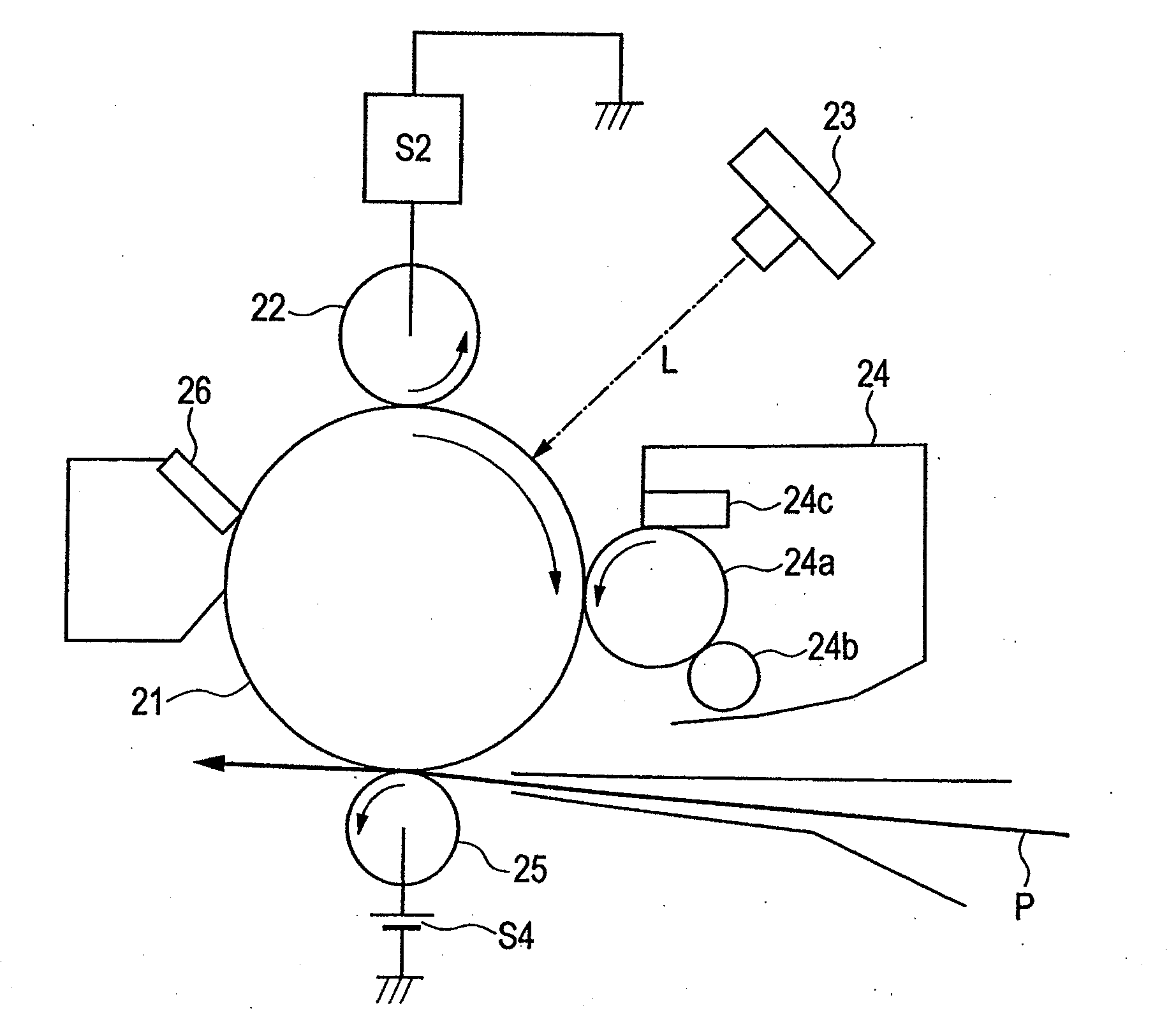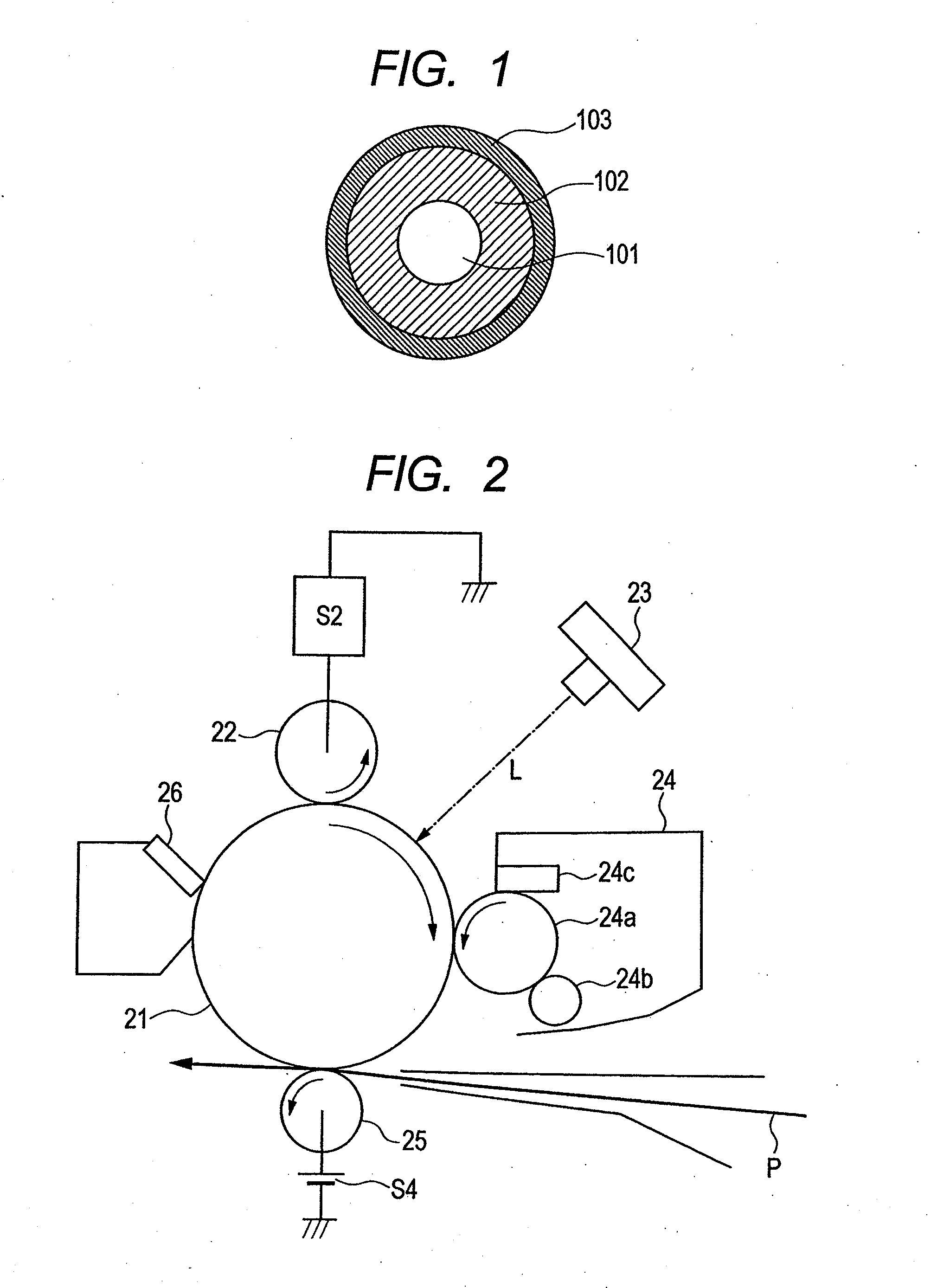Charging member, process cartridge and electrophotographic apparatus
a technology of electrophotographic apparatus and charging member, which is applied in the direction of electrographic process apparatus, instruments, corona discharge, etc., can solve the problems of oxidation of the surface of the charging member, the inability to charge the electrophotographic photosensitive member stably and surely, and the inability to easily change the charging performance with time, so as to achieve stable formation of high-grade electrophotographic images, the effect of superior charging performan
- Summary
- Abstract
- Description
- Claims
- Application Information
AI Technical Summary
Benefits of technology
Problems solved by technology
Method used
Image
Examples
example 1
(1) Formation & Evaluation of Conductive Elastic Layer
[0182]
TABLE 1Amount[part(s)Raw materialsby mass]Medium / high-nitrile NBR (trade name: NIPOL100DN219; available from Nippon Zeon Co., Ltd.)Bound acrylonitrile content center value:33.5%; Mooney viscosity center value: 27Carbon black for color (filler) (trade name:48#7360SB; available from Tokai Carbon Co.,Ltd.)Particle diameter: 28 nm; nitrogenadsorption specific surface area: 77 m2 / g;DBP oil absorption: 87 cm3 / 100 gCalcium carbonate (filler) (trade name:20NANOX #30; available from Maruo Calcium Co.,Ltd.)Zinc oxide5Stearic acid1
[0183]Materials shown in Table 1 were mixed by means of a 6-liter volume pressure kneader (trade name: TD6-15MDX; manufactured by Toshin Co., Ltd.) for 24 minutes in a packing of 70 vol. % and at a number of blade revolutions of rpm to obtain an unvulcanized rubber composition. To 174 parts by mass of this unvulcanized rubber composition, 4.5 parts of tetrabenzylthiuram disulfide (trade name: SANCELER TBzTD;...
examples 2 to 23
(1) Preparation & Evaluation of Condensates Nos. 2 to 23
[0227]Condensate intermediates 2 to 7 were prepared in the same way as the condensate intermediate 1 in Example 1 except that they were composed as shown in Table 9 below. Next, condensates 2 to 23 were prepared in the same way as the condensate 1 in Example 1 except that they were composed as shown in Table 10 below. Evaluation was made in the same way as the method described in Evaluation (1) in Example 1 except that the respective condensates obtained were used. Results obtained are shown in Table 12.
TABLE 9Synthesis 1CondensateComponent (A)Component (B)intermediateEP-1EP-2EP-3EP-4HePhNo.(g)(g)(g)(g)(g)(g)111.56———62.11—238.35———33.53—361.70———8.78—412.22———15.2756.925—9.84——64.95—6——14.98—59.63—7———11.9361.40—
[0228]Here, abbreviation symbols EP-1 to EP-5, He and Ph in the columns of the components (A) and (B) in Table 9 and also an abbreviation symbol Ti-1 to Ti-3 in the column of the component (C) in Table 10 represent the...
PUM
 Login to View More
Login to View More Abstract
Description
Claims
Application Information
 Login to View More
Login to View More - R&D
- Intellectual Property
- Life Sciences
- Materials
- Tech Scout
- Unparalleled Data Quality
- Higher Quality Content
- 60% Fewer Hallucinations
Browse by: Latest US Patents, China's latest patents, Technical Efficacy Thesaurus, Application Domain, Technology Topic, Popular Technical Reports.
© 2025 PatSnap. All rights reserved.Legal|Privacy policy|Modern Slavery Act Transparency Statement|Sitemap|About US| Contact US: help@patsnap.com



